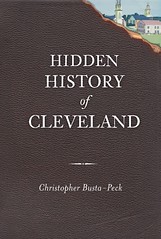
Photo by Mark Andrew Kearney, Architect
Several months ago, I came across these photos of a stunning modern house at 35850 South Woodland Road, in Moreland Hills. The photos were taken shortly before the house was demolished, in 2003.
At the time, I had tried to learn who the architect was, without any success. I recently learned that it was Ernst Payer, one of the foremost residential architects in midcentury Cleveland. The house was built in 1953.
Richard N. Campen provides some insights into the house in his 1982 manuscript, A Career in Architecture: the Ernst Payer Approach. Copies of the typewritten document are located in the collections of the Cleveland Public Library, and the libraries of John Carroll University and the Western Reserve Historical Society.

Photo by Mark Andrew Kearney, Architect
Here we see the rear of this 5,600 square foot house, built on what was at one time a 20 acre lot. The four bedrooms on the second floor shared a balcony and what must have been a lovely view. On the first floor, from left to right are a patio with barbecue, screened-in porch, and service wing, which included a garage and quarters for the help.

Photo by Mark Andrew Kearney, Architect
The massive slate squares that make up the floor throughout can be seen here at the intersection of the patio and screened-in porch. This space was clearly designed with entertaining in mind. One might note the screening to provide some privacy for those on the patio. Steel columns support the second floor.

Photo by Mark Andrew Kearney, Architect
Campen notes that the gallery, seen here, is "surfaced with redwood over which a plywood panel covered with grass-cloth is mounted as a background for paintings." It was designed specifically to house the couple's art collection. To the left, a wall of built-in cabinets is visible. Campen notes that it is "exquisitely fitted with cupboards, sliding doors, etc." and that it was designed to hold a television, Hi-Fi equipment, and a bar.

Photo by Mark Andrew Kearney, Architect
The wall of cabinets continues into a pair of fireplaces, in the living room. Campen notes that Payer was also responsible for the original landscaping and interior decoration - it is unclear how much of either remained in 2003.

Photo by Mark Andrew Kearney, Architect
The form of the awning can be clearly seen in this image, and we can imagine the views that might be present from this point. The house was designed around these views, as evidenced by the large windows throughout.
As I noted above, Ernst Payer was one of the most significant modern architects practicing in Cleveland. He was one of six architects to receive a two page spread in Cleveland Goes Modern. Richard N. Campen called this house "one of his more important residential commissions." It's of such a caliber that it would have surely been featured in Cleveland Goes Modern if it had still been standing.
Why, then, was the house demolished? It was in good condition, without any obvious significant flaws. The value of the land it sat upon was greater, it seems, than the perceived value of the house. As a result, we lost what should have been seen as one of the landmarks of modern architecture in Cleveland.
It's not just 19th century structures that we have to watch out for. We need to preserve the most important pieces of our built history regardless of age. The structures of the mid-20th century present a special set of challenges - namely, that many were designed to be invisible to the outsider - and as a result, they aren't part of our collective consciousness. We need to look harder to find them, before they are losts.




Thankyou for posting this as I am a staunch advocate of architectural preservation. Nothing incenses me more than the senseless obliteration of great architecture, especially great cleveland architecture.
ReplyDeletethe people who live out there dont understand stuff like this though, they just like new junk anymore.
ReplyDelete